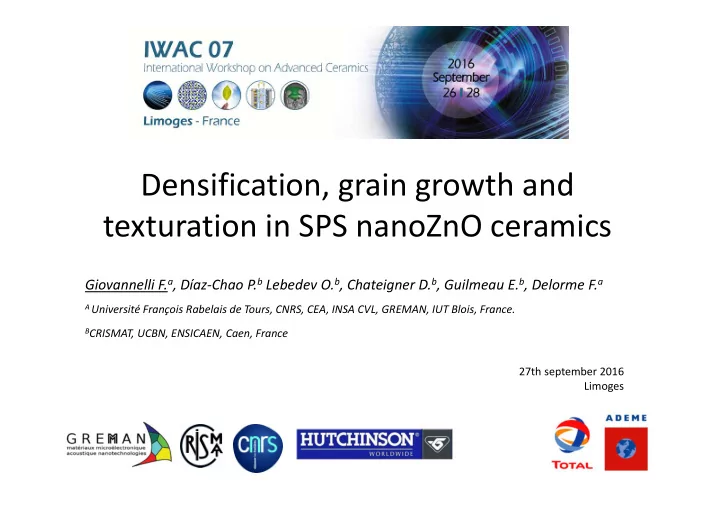

Densification, grain growth and texturation in SPS nanoZnO ceramics Giovannelli F. a , Díaz-Chao P. b Lebedev O. b , Chateigner D. b , Guilmeau E. b , Delorme F. a A Université François Rabelais de Tours, CNRS, CEA, INSA CVL, GREMAN, IUT Blois, France. B CRISMAT, UCBN, ENSICAEN, Caen, France 27th september 2016 Limoges
Motivation • Transparent oxide (Gap ~ 3.3 eV) ZnO: • Hexagonal structure • Stability at high temperatures • Biocompatible • Multiple applications: Photovoltaics, varistors, medicine… Seebeck Electrical conductivity • n-type TE oxide ZnO as • Abundant elements thermoelectric material • ZT ~ 0.6 Temperature Thermal conductivity • High densities at low temperatures Why SPS? • Small grain sizes � Low thermal conductivity ( κ ) 2
Controlled precipitation in aqueous solution 125 ml 4 M NaOH 100 ml 1 M Zn(NO 3 ) 2 ·6H 2 O (+ 5 % AlCl 3 ) Dropwise addition, stirring, 20 ° C Centrifugation (4000 rpm-5 min) Washing 4 times 3
Starting powders Starting material Al-doped ZnO - Pure and Al doped (0.3%) ZnO powder Intensity (arb. units) prepared by co-precipitation Pure ZnO - No secondary phases 1 0 1 0 0 2 - Non-isotropic morphologies 1 0 0 10 20 30 40 50 60 70 80 90 100 2 θ Pure ZnO Al doped ZnO 4
Pure ZnO Al doped ZnO Starting Powder: � No secondary phases (Al doped 0.3%) � Non-isotropic morphologies: • Pure ZnO: -platelets, flower-like structures ( c -axis in plane) • Al-doped ZnO: -platelets, isolated ( c -axis in the plane) -spherical small particles -needle like (along the c -axis) 5
• P = 100 MPa SPS sintering Conditions • 500°C < T < 1100°C • 100°C/min, 5’ 100 a ) 90 Relative Density (%) 80 70 60 50 Pure ZnO 40 Doped ZnO (Al 0.3% at.) 30 0 200 400 600 800 1000 1200 Temperature (°C) Pure ZnO T<800°C � Low densities (<70%) Al-doped ZnO T > 800°C � High densities (>90%) T > 500°C � High densities (>90%) 6
Al:ZnO (0.3%) Pure ZnO 1000°C XRD on Intensity (arb. units) 1100°C Intensity (arb. units) 800°C the surface 1000°C 600°C 800°C 500°C 600°C 28 30 32 34 36 38 40 28 30 32 34 36 38 40 2 θ 2 θ Pure ZnO Al doped ZnO • Low texturation degree • High texturation degree • Evolution of the 1 0 0 peak • Suppression of the 0 0 2 peak • c -axis perpendicular to pressure 7
Pure ZnO Al doped ZnO φ γ 600°C 500°C φ γ 800°C 600°C 1000°C 800°C 1000°C 1100°C • High texturation degree • Low texturation degree • (1 0 0)//pressure • Low T: (1 0 0)//pressure axis ∀ T • (0 0 2) ⊥ pressure • High T: (0 0 2)//pressure axis 8
MORPHOLOGY: Isotropic grain Al-doped ZnO 500 ° C Intensity (arb. units) Intensity (arb. units) 28 30 32 34 36 38 40 28 30 32 34 36 38 40 2 θ 2 θ Cross Section Surface 9
MORPHOLOGY: Evolution of the grain size Al doped ZnO Pure ZnO Pure ZnO: Al doped ZnO: -Isotrope grains at high temperatures -Isotrope grains at all temperatures -Grain growth from T > 800°C -Grain growth from T ~ 500°C 10
DENSIFICATION MECHANISM Pure ZnO Al doped ZnO 11
Thermoelectric properties: influence of the texturation 0.06 -280 Thermal conductivity (W/m·K) c ) 30 a ) Perpendicular pressure direction Perpendicular pressure direction b ) Parallel pressure direction Parallel pressure direction -300 25 0.05 -320 ρ ( Ω ·cm) S (µV/K) 20 -340 15 0.04 -360 Perpendicular pressure direction 10 Parallel pressure direction 0.03 -380 5 100 200 300 400 500 600 700 100 200 300 400 500 600 700 100 200 300 400 500 600 700 T (°C) T (°C) T(°C) � Perpendicular to pressure direction (c-axis randomly in plane) � Parallel to pressure direction (1 0 0 direction) • No influence of texturation on Seebeck and thermal conductivity • Low influence of texturation on electrical resistivity � 1 0 0 direction more resistive at room temperature � No influence at high temperatures (T > 300°C) 12
Sintering Powder synthesis 80% 98% Al doped ZnO 60 ° C 800°C , 5 min 850°C , 30 min 100 nm 86% - Isotropic nanoparticles (< 50 nm) 900°C , 5 min 13
Effect of microstructure on thermal conductivity at 50°C Pure ZnO Al doped ZnO Interconnected platelets Nanoparticles Platelets + nanoparticles 850°C/30 min 500°C 800°C 35 W/m K 34 W/m K 45 W/m K 29 W/m K Nanoparticles 12 W/m K 14
Conclusions Starting powder: • Synthesis by co-precipitation of pure and 0.3% Al-doped ZnO • Non isotropic morphologies - Flower like structures in pure ZnO - Isolated platelets, nanoparticles and needles in doped ZnO • Isotropic nanoparticles in doped ZnO SPS : • Dense ceramic at 500°C • Differences in shrinkage due to different starting morphologies TE properties (doped samples): • No influence of texturation on Seebeck and thermal conductivity • Influence of texturation on the electrical resistivity: - Higher resistivity along the 100 direction at low T (T < 300°C) - No influence at high temperatures (T > 300°C) 15
Thank you for your attention Densification, grain growth and texturation in SPS nanoZnO ceramics Giovannelli F. a , Díaz-Chao P. b Lebedev O. b , Chateigner D. b , Guilmeau E. b , Delorme F. a A Université François Rabelais de Tours, CNRS, CEA, INSA CVL, GREMAN, IUT Blois, France. B CRISMAT, UCBN, ENSICAEN, Caen, France 16
Recommend
More recommend